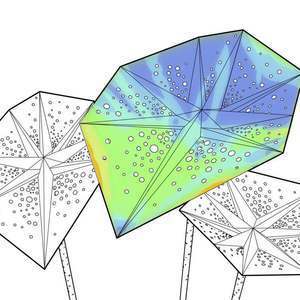Date: 2014-11-01 00:00:00 +0000 UTCTags: scalar, field, oxford, brookes, rain, pavilion, optimisation, stress, structure
Void distribution in relation to scalar fields
A scalar field can represent a number of different states such as contours of stress within a solid body, a map of solar gain on a building facade or even a photographic image with no intrinsic technical qualities.
Through our work on the Oxford Brookes Rain Pavilion we have developed an approach to mapping a physical object or pattern onto the scalar field which has a potentially wide application to Engineering and Architectural Design. In the context of the Rain Pavilion this was a distribution of circular holes cut into the steel plate canopies and tubular stems set out in relation to the level of stress in that element, expressed as a colour map determined by finite element analysis. Effectively, this equates to removing material from where it is least needed and hence reduces the volume of structure required.
This technique was described in the following paper:
- Nielsen, T.H.; Melville, S.M.; Sproat, I., 2014: Populating surfaces with holes using particle repulsion based on scalar fields. In: Thompson, E.M. (ed.): Fusion - Proceedings of the 32nd eCAADe Conference - Volume 1, 10-12 September 2014, pp. 537-545.
